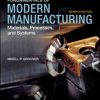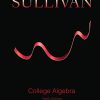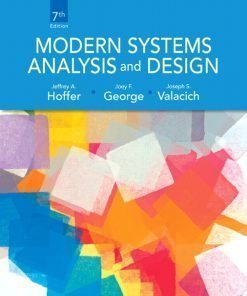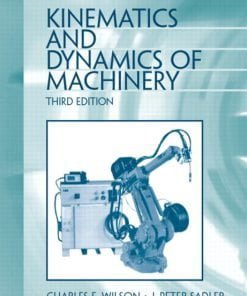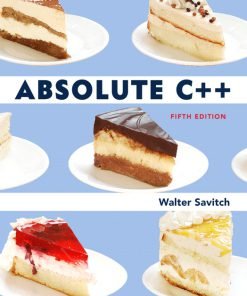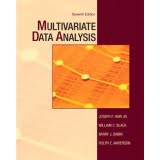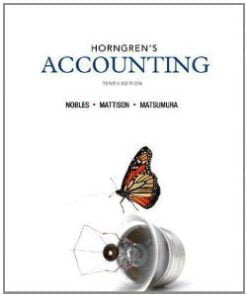Electrical Control for Machines 7th Edition Lobsiger Solutions Manual
$35.00 Original price was: $35.00.$26.50Current price is: $26.50.
Electrical Control for Machines 7th Edition Lobsiger Solutions Manual
Electrical Control for Machines 7th Edition Lobsiger Solutions Manual

Product details:
- ISBN-10 : 9781133693383
- ISBN-13 : 978-1133693383
- Author: Diane Lobsiger
Reflecting the latest trends and practices from industry, the cutting-edge new ELECTRICAL CONTROLS FOR MACHINES, 7e delivers a thorough introduction to the range of technologies found in today’s electrical machine controls. Completely up to date, circuit diagrams and the descriptions of the circuits illustrate a modern representation of the controls circuits. The text also offers expansive coverage of the power and control circuitry required to operate electrical machinery. While it discusses the trend away from relay control to PLC control, the text maintains solid coverage of relay circuits. Its emphasis on the critical importance of worker and equipment safety in industrial settings includes a detailed explanation of the risk assessment process and a safety relay circuit. In addition, the inclusion of international equipment specifications reflects the dramatic impact of globalization and integration of businesses on the way industries function.
Table contents:
- Ch 1: Transformers and Power Supplies
- 1.1 Control Transformers
- 1.2 Transformer Regulation
- 1.3 Sizing a Transformer
- 1.4 Operating Transformers in Parallel
- 1.5 Temperature Rise in a Transformer
- 1.6 50-Hz vs 60-Hz Operation
- 1.7 Constant Voltage Regulators
- 1.8 Power Supplies for Control Voltage
- 1.9 Uninterruptible Power Systems (UPS)
- 1.10 Circuit Diagram
- 1.11 Insulation Classifications
- 1.12 Conductor Ampacity
- 1.13 Conductor Color Code
- 1.14 Electrical Symbols
- Ch 2: Fuses, Disconnect Switches, and Circuit Breakers
- 2.1 Protective Factors
- 2.2 Fuse Construction and Operation
- 2.3 Fuse Types
- 2.4 Peak Let-Thru Current (Ip) and Ampere Squared Seconds (I2t)
- 2.5 Voltage and Frequency Surges
- 2.6 Circuit Breaker Types
- 2.7 Programmable Motor Protection
- 2.8 Electrical Metering and Voltage Protection
- 2.9 Selecting Protective Devices
- 2.10 Ground Fault Circuit Interrupter
- Ch 3: Control Units for Switching and Communication
- 3.1 Oil-Tight Units
- 3.2 Push-Button Switches
- 3.3 Selector Switches
- 3.4 Heavy-Duty Switches
- 3.5 Indicating Lights
- 3.6 General Information on Oil-Tight Units
- 3.7 Circuit Applications
- 3.8 Annunciators
- 3.9 Light-Emitting Diodes
- 3.10 Membrane Switches
- Ch 4: Relays
- 4.1 Control Relays and Their Uses
- 4.2 Timing Relays
- 4.3 Latching Relays
- 4.4 Plug-In Relays
- 4.5 Contactors
- Ch 5: Solenoids
- 5.1 Solenoid Action
- 5.2 Solenoid Force and Voltage
- 5.3 Low Voltage
- 5.4 Overvoltage
- 5.5 AC Solenoids on DC
- 5.6 DC Solenoids on AC
- 5.7 50- and 60-Cycle Solenoids
- 5.8 Solenoid Temperature Rise
- 5.9 Valve Operation
- 5.10 Circuit Applications
- 5.11 Variable Solenoids
- 5.12 Proportional Valves
- 5.13 Servo Valves
- Ch 6: Types of Control
- 6.1 Open-Loop Control
- 6.2 Closed-Loop Control
- 6.3 Proportional Control
- 6.4 Proportional-Integral
- 6.5 Proportional-Integral-Derivative
- 6.6 Proportional-Integral-Derivative Examples
- Ch 7: Motion Control Devices
- 7.1 Importance of Position Indication and Control
- 7.2 Limit Switches-Mechanical
- 7.3 Limit Switch Symbols
- 7.4 Circuit Applications
- 7.5 Proximity Limit Switches
- 7.6 LED Indicators
- 7.7 Solid-State Outputs
- 7.8 Detection Range
- 7.9 Hysteresis
- 7.10 Attenuation Range
- 7.11 Speed
- 7.12 Magnet-Operated Limit Switch
- 7.13 Vane Switches
- 7.14 Linear Position Displacement Transducers
- 7.15 Angular Position Displacement Transducers
- 7.16 Use of AC Synchronous and DC Stepping Motors
- 7.17 Servo Positioning Control
- 7.18 Sensing Theory
- 7.19 Flow Sensors
- Ch 8: Pressure Control
- 8.1 Importance of Pressure Indication and Control
- 8.2 Types of Pressure Switches
- 8.3 Circuit Applications
- Ch 9: Temperature Control
- 9.1 Importance of Temperature Indication and Control
- 9.2 Selection of Temperature Controllers
- 9.3 Electronic Temperature Controller (Pyrometer)
- 9.4 Controller Outputs
- 9.5 Additional Terms
- 9.6 Temperature Switches (Thermostats)
- 9.7 Temperature Sensors
- 9.8 Circuit Applications
- Ch 10: Time Control
- 10.1 Selected Operations
- 10.2 Types of Timers
- 10.3 Synchronous Motor-Driven Timers
- 10.4 Solid-State Timers
- 10.5 Circuit Applications
- Ch 11: Count Control
- 11.1 Electromechanical Control Counters
- 11.2 Circuit Applications
- 11.3 Solid-State Counters
- Ch 12: Control Circuits
- 12.1 Placement of Components in a Control Circuit
- 12.2 Control Circuit Examples
- Ch 13: Motors and Drives
- 13.1 DC Motors-Principles of Operation
- 13.2 DC Motors
- 13.3 AC Motors-Theory of Operation
- 13.4 Polyphase Squirrel-Cage Induction Motors
- 13.5 Variable Frequency Drives
- 13.6 Single-Phase Motors
- 13.7 Resistance Split-Phase Motors
- 13.8 Capacitor Start Motors
- 13.9 Permanent Split-Capacitor Motors
- 13.10 Shaded-Pole Motors
- 13.11 Brushless DC Motors
- Ch 14: Motor Starters
- 14.1 Contacts and Overload Relays
- 14.2 Across-the-Line (Full-Voltage) Starters
- 14.3 Reversing Motor Starters
- 14.4 Multispeed Motor Starters
- 14.5 Additional Across-the-Line Starter Circuits
- 14.6 Reduced-Voltage Motor Starters
- 14.7 Solid-State Motor Starters
- 14.8 Starting Sequence
- Ch 15: Introduction to Programmable Control
- 15.1 Primary Concepts of Relay Control
- 15.2 Introduction to Programmable Logic Controllers
- 15.3 Programmable Logic Controller Concepts
- 15.4 PLC Input/Output (I/O)
- 15.5 Processor
- 15.6 Memory
- 15.7 Power Supplies
- 15.8 Programming
- 15.9 Examine On/Examine Off
- 15.10 Peripheral and Support Devices
- 15.11 Data Communications
- 15.12 Converting from Relay Logic to PLC
- Ch 16: Industrial Data Communications
- 16.1 Overview
- 16.2 Industrial Information Technology Architecture
- 16.3 Data Communication Network Concepts
- 16.4 Data Transmission
- 16.5 Industrial Data Highway
- 16.6 Network Topologies
- 16.7 Industrial Networks
- 16.8 Data Transfer Rate
- 16.9 Ethernet and the Information Highway
- 16.10 Transmission Media
- 16.11 Troubleshooting Networks
- 16.12 Open Systems versus Proprietary Systems
- 16.13 Network Layers
- 16.14 Typical Network Systems
- Ch 17: Quality Control
- 17.1 Defining Quality and Quality Control
- 17.2 Electrical and Electronic Circuits Used in Quality Control
- 17.3 Quality Achieved through Machine and Process Monitoring
- 17.4 Process Tolerance (Standards)
- 17.5 Information Systems
- 17.6 Maintaining Quality
- Ch 18: Safety
- 18.1 Worker Safety
- 18.2 Machine Safety
- 18.3 Diagnostic Systems
- 18.4 Machine Safety Circuit
- 18.5 Programmable Controllers in Safety
- 18.6 Other Safety Conditions
- Ch 19: Troubleshooting
- 19.1 Safety First
- 19.2 Analyzing the Problem
- 19.3 Major Trouble Spots
- 19.4 Equipment for Troubleshooting
- 19.5 Motors
- 19.6 Troubleshooting a Complete Control Circuit
- 19.7 Troubleshooting the Programmable Logic Controller
- 19.8 Electronic Troubleshooting Hints
- Ch 20: Designing Control Systems for Easy Maintenance
- 20.1 Design Considerations
- 20.2 Diagrams and Layouts
- 20.3 Locating, Assembling, and Installing Components
- Appendix A: Summary of Electrical Symbols
- Appendix B: Units of Measurement
- Appendix C: Rules of Thumb for Electric Motors
- C.1: Horsepower versus Amperes
- C.2: Horsepower Revolutions per Minute-Torque
- C.3: Shaft Size-Horsepower-Revolutions per Minute
- Appendix D: Electrical Formulas
- Appendix E: Use of Electrical Codes and Standards
- E.1: Major Goals
- E.2: The History of the NFPA 79 Standard
- E.3: Tables
- Appendix F: Application of Electric Heat
- F.1: Calculating Heat Requirements
- F.2: Selection and Application of Heating Elements
- Appendix G: Power Factor Correction
- G.1: Apparent Power and Actual Power
- G.2: Magnetizing Current and Power Current
- G.3: Determining the Amount of Correction Required
- G.4: Typical Capacitor Design Features
- Glossary
- Index
People also search:
electrical control for machines 7th edition
what is it called when machines control machines
electric machine name
a control can be which of the following
electrical control for machines
Related products
Solution Manual
Solution Manual
Solution Manual
Solution Manual for Absolute C++, 5/E 5th Edition Walter Savitch
Solution Manual
Solution Manual
Solution Manual for Data Structures and Other Objects Using C++, 4/E Michael Main, Walter Savitch


